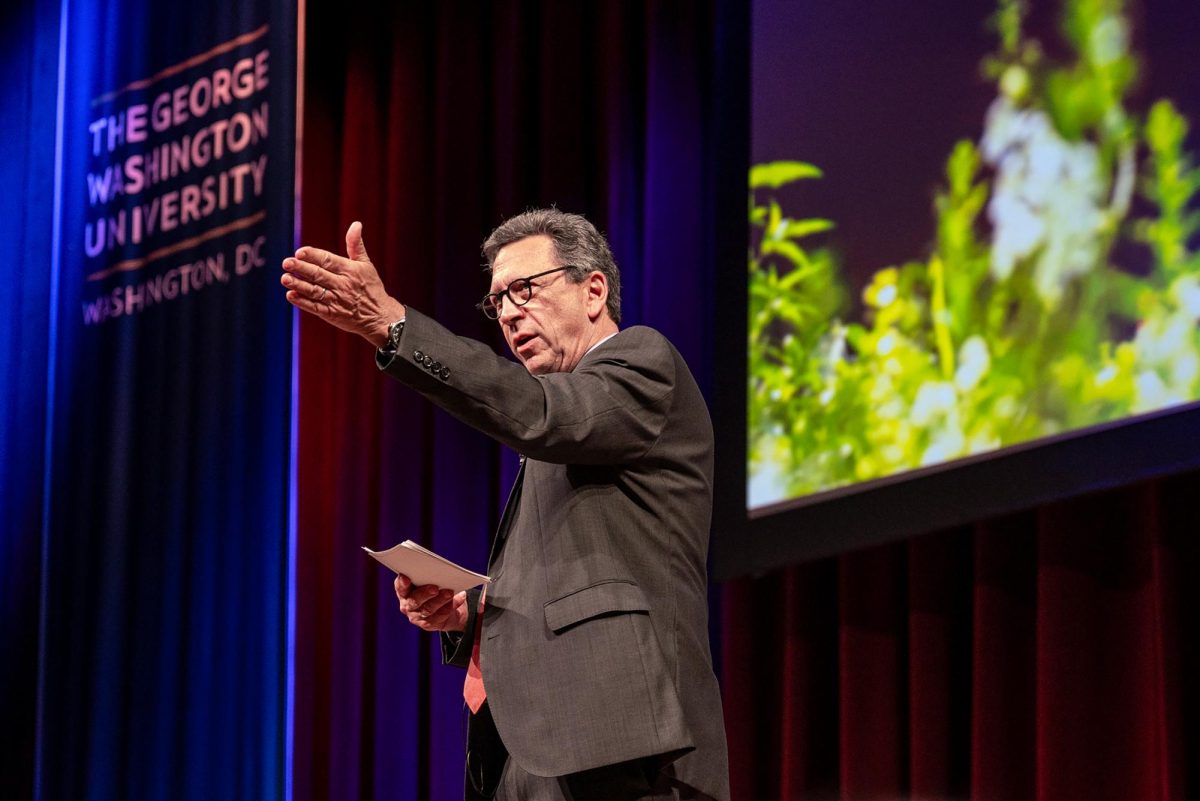
Arwen Clemans | Staff Photographer
Frank Sesno presents at the organization's official launch on April 17.
The School of Media & Public Affairs announced the development of a new master’s degree concentration earlier this month.
Frank Sesno, the executive director of the GW Alliance for a Sustainable Future and director of strategic initiatives at SMPA, announced a new master’s concentration in Sustainability and Climate Communication at an event discussing climate change with Sen. Chris Coons (D-DE) earlier this month. Sesno said adding the new concentration responds to student interest and the growing importance of the response to climate change, which he called the “calling of a generation.”
The concentration, which will launch in fall 2024, will add a new set of electives in the areas of science, policy, climate and sustainability for graduate students participating in the SMPA master’s degree program in Media and Strategic Communication. The school will also add a required environmental and science communication course, which officials are still developing, along with a media capstone project or thesis relating to climate change or sustainability, according to SMPA officials.
Sesno said the concentration was formed by leveraging SMPA’s assets regarding environmental communication, including his Sustainability Reporting class, the Ted Turner Visiting Professor of Environmental Media housed in the school, student interest and his work as the executive director of the GW Alliance for a Sustainable Future. He added that he has seen a rise in student interest as students discuss climate change in a more personal light due to how it has impacted students, like living near a wildfire zone or near a coast with rising sea levels.
“Climate change has become very real and very personal, and that’s something that helped us determine that there was a need and a market for this kind of thing,’’ Sesno said.
Sesno said students who participate in the program will become “instantly competitive” in the job market due to the projected growth in jobs related to sustainability and climate change and can apply skills they learn in the concentration to different types of jobs, ranging from running for public office to becoming a speechwriter, engineer or chief sustainability officer. He said students’ ability to take classes across disciplines and schools within GW allows students to take electives that align with their interests to make them good communicators.
“You have to be able to fashion a thought, communicate data, connect people with ideas and stories so that they understand and support and fund or whatever it is you’re trying to accomplish,” Sesno said.
Sesno said he hopes students who come out of the concentration are “rockstars” in communicating the “fundamental” issues of climate change and sustainability. He said he hopes the students will be effective communicators to combat the “noise” and disinformation surrounding climate change.
“I hope that a graduate student in our master’s of Media and Strategic Communication with the concentration in this space will come away with a better understanding of the issue and the complexity of it, a better appreciation for what it takes to convey it, to communicate it to distinct audiences, a better understanding of those audiences,” Sesno said. “After all, there are climate deniers on one end and climate alarmists on the other.”
Peter Loge, the director of SMPA, said school officials provided information about the new program at the Planet Forward summit and plan on continuing to market the program to prospective graduate students at other universities.
“As we roll out the program and we get better at it, then we’ll find other places to talk to other students at other universities who were interested in communications or who come out of a science background who want to learn comms or people come up with a comms background who want to now focus on the science,” said Loge.
Loge said the development of this program contributes to a larger, University-wide commitment to sustainability.
“Our little program we’re starting in our little corner of SMPA, really is part of this larger University commitment to forward thinking, working together on critical issues like climate and sustainability, in ways that only GW can do,” Loge said.
Lisa Palmer, a research professor of science communication and senior editor and education lead for Planet Forward, said communication surrounding sustainability and the climate crisis is “more complex” than just about any other kind of communication due to the large context of the issues surrounding it.
“Because this kind of communication is often very science-based and technical and involving environmental science and environmental issues, which are very cross-cutting, they’re interconnected across a lot of different social, economic and environmental issues,” Palmer said.
Palmer said GW is “very well-placed” for a program like this because it is so close to both national and global institutions and organizations. The Environmental Protection Agency, the United States Department of Interior and National Geographic are all located near the Foggy Bottom Campus.
“Climate change and a lot of these other issues around biodiversity and environment are very global in scale, but they’re also equally as important to be focused on in a local or state and regional context. GW is well placed to operate at all of those scales, because all of them are needed,” Palmer said.
Sean Aday, an associate professor of media and public affairs and the graduate director for Media and Strategic Communication, said there is no other more important issue in the world right now than climate change.
“I can think of no better time to add this concentration than now, especially given the importance of the issue to young people in general and students specifically, who, after all, will be dealing with these issues and their ramifications for the rest of their lives,” Aday said in an email.